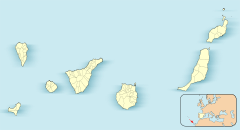 The INT dome by moonlight | |
| Alternative names | Isaac Newton Telescope 2.5m |
|---|---|
| Part of | Isaac Newton Group of Telescopes Roque de los Muchachos Observatory Royal Observatory |
| Location(s) | La Palma, Atlantic Ocean, international waters |
| Coordinates | 28°45′44″N 17°52′39″W / 28.7622°N 17.8775°W |
| Organization | Isaac Newton Group of Telescopes |
| Built | 1967–1984 |
| Telescope style | Cassegrain reflecting telescope Newtonian telescope |
| Diameter | 2.54 m (8 ft 4 in) |
| Collecting area | 5 m2 (54 sq ft) |
| Focal length | 8.36 m (27 ft 5 in) |
| Mounting | equatorial mount |
| Enclosure | spherical dome |
| Website | www |
| | |
The Isaac Newton Telescope or INT is a 2.54 m (100 in) optical telescope run by the Isaac Newton Group of Telescopes at Roque de los Muchachos Observatory on La Palma in the Canary Islands since 1984.
Originally the INT was situated at Herstmonceux Castle in Sussex, England, which was the site of the Royal Greenwich Observatory after it moved away from Greenwich due to light pollution. It was inaugurated in 1967 by Queen Elizabeth II.[1]
Herstmonceux suffered from poor weather, and the advent of mass air travel made it plausible for UK astronomers to run an overseas observatory. In 1979, the INT was shipped to La Palma, where it has remained ever since. It saw its second first light in 1984, with a video camera.[2][3] A major change was the mirror was now made of the new type Zerodur glass, as compared to the old mirror's Pyrex glass.[4]
Until 2024, the main instruments were the Wide Field Camera (WFC) and Intermediate Dispersion Spectrograph (IDS). WFC is a four CCD photographic prime-focus instrument with a relatively large 0.56×0.56 square degree field of view, which was commissioned in 1997. IDS is a medium-low resolution optical spectrograph (R 550-9375).[5] As of mid 2024 the INT is undergoing upgrades in preparation for the installation of HARPS3,[6] after which it will be the main instrument.
The old site of the INT is now the Observatory Science Centre at Herstmonceux, and it is known for its distinctive greened copper dome and various science and astronomy activities.[7]
- ^ Smith, F. Graham; Dudley, J. (1982). "The Isaac Newton Telescope". Journal for the History of Astronomy. 12 (1): 1–18. Bibcode:1982JHA....13....1S. doi:10.1177/002182868201300101. S2CID 116989341. Retrieved 18 February 2016.
- ^ "Chronology of the Isaac Newton Group of Telescopes".
- ^ Cite error: The named reference
lightwas invoked but never defined (see the help page). - ^ Porter, John Guy; Moore, Patrick (1984). Yearbook of Astronomy. W. W. Norton. ISBN 9780393301472.
- ^ "Gratings". www.ing.iac.es. Retrieved 2024-08-25.
- ^ "ING Instrumentation Update 2024 - 2025". www.ing.iac.es. Retrieved 2024-08-25.
- ^ Treadwell, Timothy (2017-03-29). Astronomy Adventures and Vacations: How to Get the Most Out of Astronomy in Your Leisure Time. Springer. ISBN 9783319500027.
